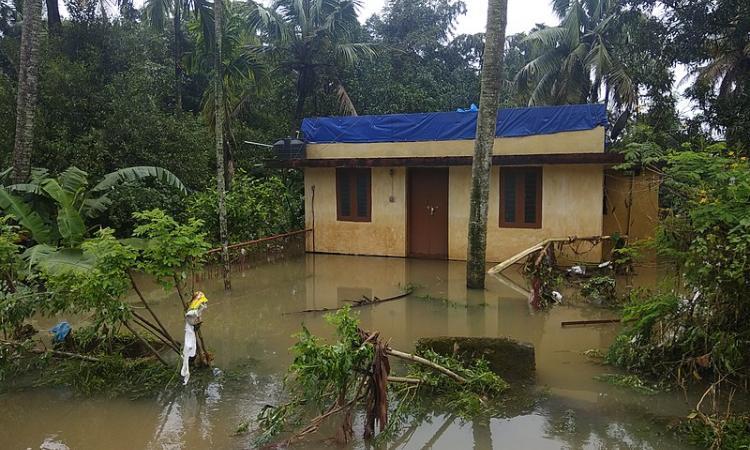
The states of Andhra Pradesh, Karnataka, Kerala, and Tamil Nadu are in the news since the last few days because of the heavy rains that have left the region battered by flooding and water-logging at several places leading to reports of death, destruction and displacement of large populations in the area. As if this is not enough, the India Meteorological Department (IMD) has warned of more rains to come over the next few days!
Extreme weather events (EWEs) such as floods, heatwaves, cold waves, tropical cyclones, lightning, heavy rainfall are becoming very frequent in India, leading to huge losses to lives and property and threats to the livelihoods of vulnerable communities.
There has been an 18 percent increase in annual EWEs in the time span of 2007–2016 as compared to 1997–2006 in India, informs this paper titled 'An assessment of long-term changes in mortalities due to extreme weather events in India: A study of 50 years’ data, 1970–2019' published in the journal Weather and Climate Extremes.
The paper highlights the critical need to analyse the recent extreme events for better planning at the policy level and for devising disaster management strategies. The study presents an analyses of the major EWEs in India over the past five decades (1970–2019) by using India Meteorological Department (IMD) data.
The analysis finds that:
There have been 7063 extreme events causing 141,308 deaths with an average of 20 deaths per event in the last fifty years in India.
Floods have been the most frequent with high deaths
Floods have been found to be the most frequently occurring extreme events responsible for highest deaths at 46 percent followed by tropical cyclones with 28.6 percent deaths. Heat and cold waves have led to 12.3 percent and 6.8 percent deaths respectively, while lightning has led to 6.3 percent deaths.
Tropical cyclones have been the most destructive compared to any other EWEs and the death caused due to cyclones show four prominent peaks during the Odisha Cyclone in 1971, Andhra Pradesh Cyclone in 1977, Odisha Super Cyclone in 1999, and the Uttarakhand Floods in 2013.
While EWEs have increased, there has been a decrease in the mortality rate (mortalities per year per million population) for heatwaves and floods, during the last 50 years. Thus, deaths due to EWEs were maximum during the decade of 1970–1979 and majority (88 percent) of these were due to floods and tropical cyclones. This was because of three major cyclones that happened in the decade. They were lower in 1980–1989 and have reduced by 66 percent in 2000 -2019.
Floods and heatwaves have taken more lives in 2000-2019.
Of the deaths reported in the last decade, 49 percent have been due to floods and 24 percent due to heatwaves.
Floods due to heavy rainfall have been the most common causes of flooding during the last decade of 2000-2019 and include the 2013 Uttarakhand floods, the 2014 Srinagar floods; the 2015 Chennai floods and the 2017 Gujarat floods. Besides climate change, human induced anthropogenic activities such as urbanisation, encroachments have led to deaths associated with floods.
However, deaths due to floods have reduced over the decades with them decreasing by 3 to 5 percent in each decade from 1980 to 2009, and by 20 percent in the last 10 years, despite the increase in the total flood events.
Heat waves have now become the second most disastrous events linked to mortality. Mortality rates have increased by almost 27 percent in 2010–2019 as compared to 2000–2009 with a corresponding increase in the number of heatwave events.
However, deaths due to tropical cyclones have decreased by almost 88 percent in the last decade 2010–2019 in comparison to the earlier decade 2000–2009, despite the significant increasing trend of severe tropical cyclones during the post-monsoon season over Bay of Bengal.
EWEs experienced by states
The highest deaths per year in the past 50 years have been reported from the state of Andhra Pradesh (which included Telangana state till 2014), followed by the states of Odisha, Uttar Pradesh, West Bengal, and Bihar.
State-level analysis shows that Odisha has the highest mortalities per year due to tropical cyclones, Andhra Pradesh due to heatwaves, Uttar Pradesh due to floods and Bihar has had the highest mortalities due to cold waves. The highest mortality due to lightning was found in Maharashtra.
Mortality due to heatwaves is high in the states of Andhra Pradesh, Uttar Pradesh, Odisha, Bihar, and Rajasthan while due to cold waves is high in the states of Bihar, Uttar Pradesh, and Jharkhand.
The mortality rates due to tropical cyclones in most of the affected states of Andhra Pradesh, Odisha, Gujarat, and West Bengal show a declining trend while that due to floods has decreased in Andhra Pradesh, Assam, Gujarat, and Odisha and increased in Kerala.
The mortality rates due to lightning have increased in most of the vulnerable states with the highest increase being in Odisha in the last two decades.
The high population states like Andhra Pradesh, Bihar, Odisha, Assam, Maharashtra, Kerala, and West Bengal suffer from maximum mortalities by EWEs and there is a need to prioritise these states for developing action plans, argues the paper.